In the 21 games preceding their two poor showings against the Toronto Maple Leafs, the New Jersey Devils put up an expected goal percentage of 51 despite lacking their big off-season signing, Dougie Hamilton. That was a decent run of play fully submarined by getting a combined team save percentage of .873. The Devils haven’t been a bad team, but boy, the two games they played against the Leafs — more specifically the final four periods — were absolute season-worst stinkers for them. Because of that reality I’m not sure we learned much about what the Maple Leafs are in the big picture, despite them handily taking the four points offered up on a silver platter.
What has become evident though, is that the Leafs offence is what we expected it to be heading into the season — extremely potent — but there’s still room for it to grow. A few of their goals against the Devils — an opponent that wasn’t offering a ton of resistance — allowed us to see what it is they want to do when they’re allowed free rein. We’ll look at that here today.
First here are the NHL’s five leading teams in goals per game so far this season.

The Wild! Who’d a thunk it? Otherwise there’s no surprises there, those are all teams we knew could score.
To get a sense for how the Leafs earned inclusion on that list, here’s a look at a their heat map (all images are from Micah Blake McCurdy’s Hockey Viz site). The red shows where they take more shots than league average, which results in an impressive picture. They don’t waste possessions shooting from the outside compared to the rest of the league, instead waiting to get it in to the more dangerous areas. (You also won’t be surprised to know that very little offence comes from their D shooting the puck.)

What stands out most to me aside from the sheer amount of shots is that tongue of red up high in the middle of the offensive zone. It’s also interesting their bullseye of dark red is closer to between the hashmarks than right on top of the crease.
For comparison, here’s the heat map of the team one spot ahead of them in goals, Minnesota:

Not much of a pattern there, some light pink in the high slot. Now Colorado:

The Avs are a little more scattered than the Leafs, too, though they have a red spot even higher in the middle of the zone as well. However, they actually aren’t that active from where the Leafs are best — the inner slot.
If you were to look at all the heat maps around the league, few teams are as effective at opening up that sweet spot as Toronto. Even among those that are great at getting to the good ice (Florida is the league’s best), most don’t use the high slot quite like Toronto. Carolina’s shots are either on top of the goalie (which is great), or shooting from out by the boards.
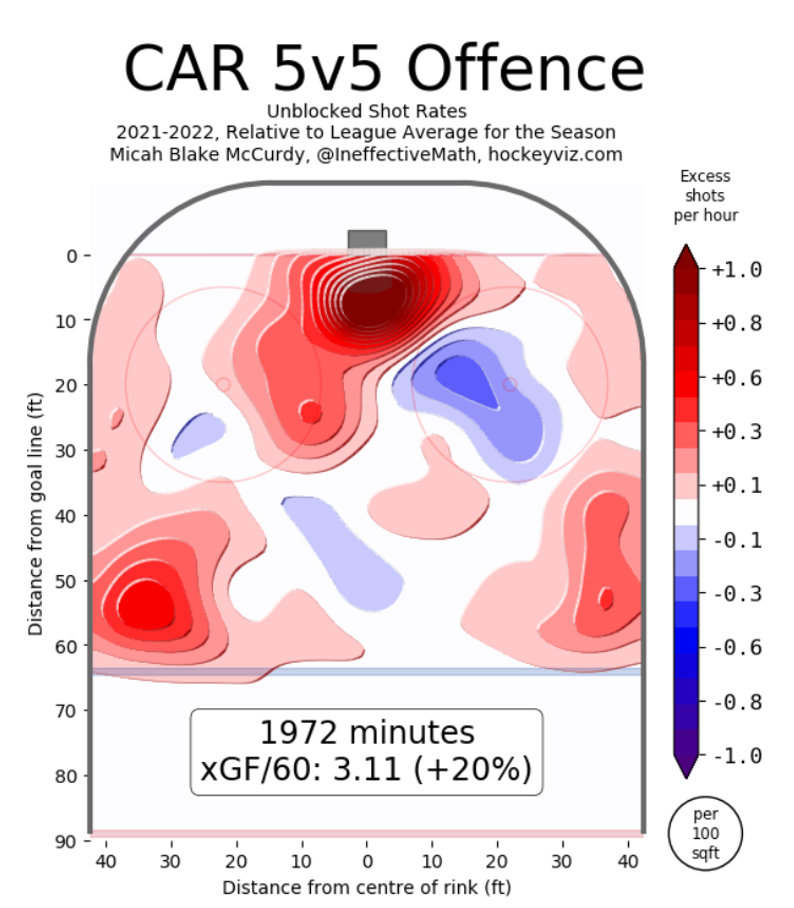
They’re not quite as busy in the high slot.
I was at a Leafs practice earlier this season and watched them work on having their F3 not just supporting the puck, but coming out high almost to where they’re between their own D, that way they can come downhill and get shots from above the pile with some oomph.
In theory that should pull defenders higher in the zone, allowing them to get the more dangerous looks they’d prefer from closer in to the net. When the defenders don’t come higher, as the sagging Devils D selected, that’s when the Leafs are able to get shots off that have a purpose.
Take a look at the Matthews goal. He starts below the goal line as Marner battles for the puck up by the top of the circles…
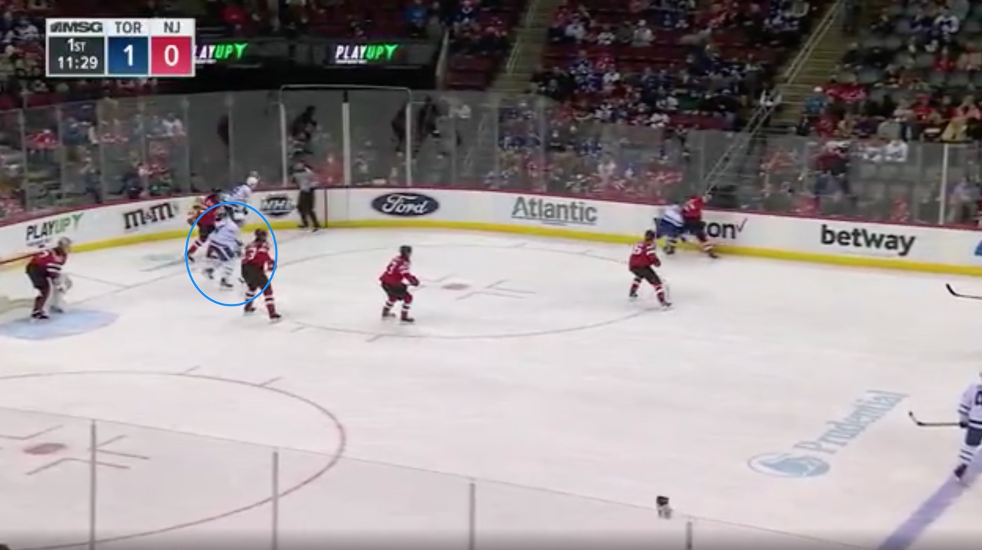
…And instead of crowding the puck battle, he pulls into that high soft pocket to be an option.
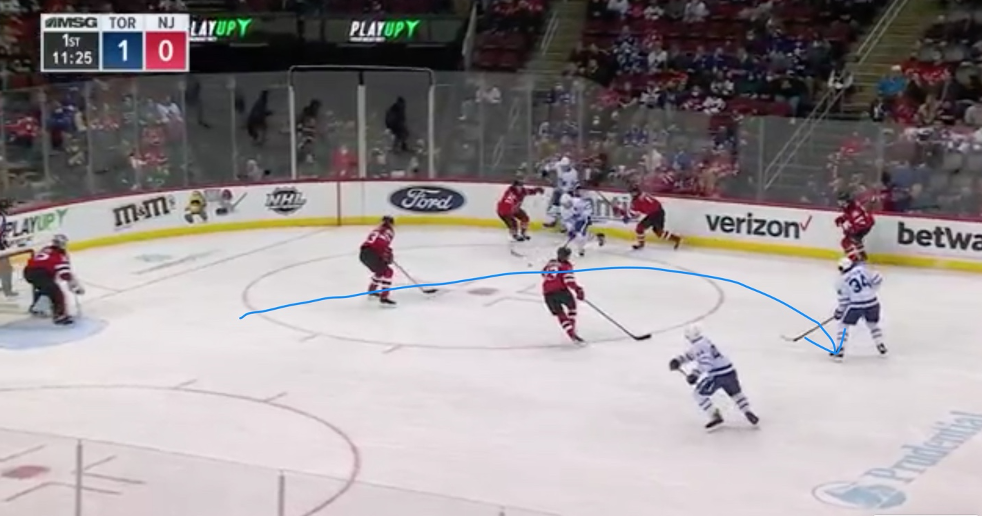
When Marner wins the battle and jumps off the wall with the puck, the D have no chance to defend Matthews. They can’t just give Marner net access.
So when nobody comes out to find big ol’ No. 34, he’s able to get off his wrist shot which insightful hockey analysts like myself have deemed “quite good.”
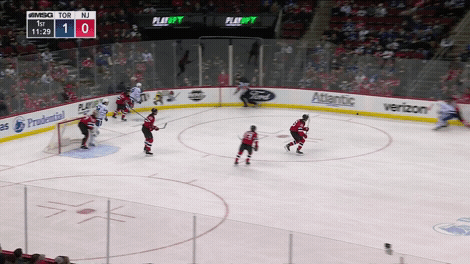
It’s about complicating the coverage for defenders. How high should you wander up away from the goalie to defend shots from there, leaving open ice at the more dangerous spot on the rink?
What happens when a team doesn’t trust their goalie so much (see: the Devils), is they defend the close ice around the crease with all their might, and leave as many of the attempts to come from distance as possible. You have to assume anyone good enough to make the NHL has a chance on shots from distance, so the D tend to sag low. As the Leafs have all season — and as you saw in their heat map — they looked up above to find ice. The Kampf goal was off a rush, but still showed the Leafs forwards at least looking to that ice as an offensive option.

The above is a result of over-backchecking as much as anything, but again, that feels like the result of a team that doesn’t trust their goalie. There’s that desperation “EVERYONE BACK AND HUNT THE PUCK, DON’T LET THEM GET A GOOD CHANCE” that leads to the Leafs getting a look from where they like to hang out.
Even the Pierre Engvall goal is a guy who does a shortened version of curling above into the higher slot to find a puck.
Off the draw he ends up low…
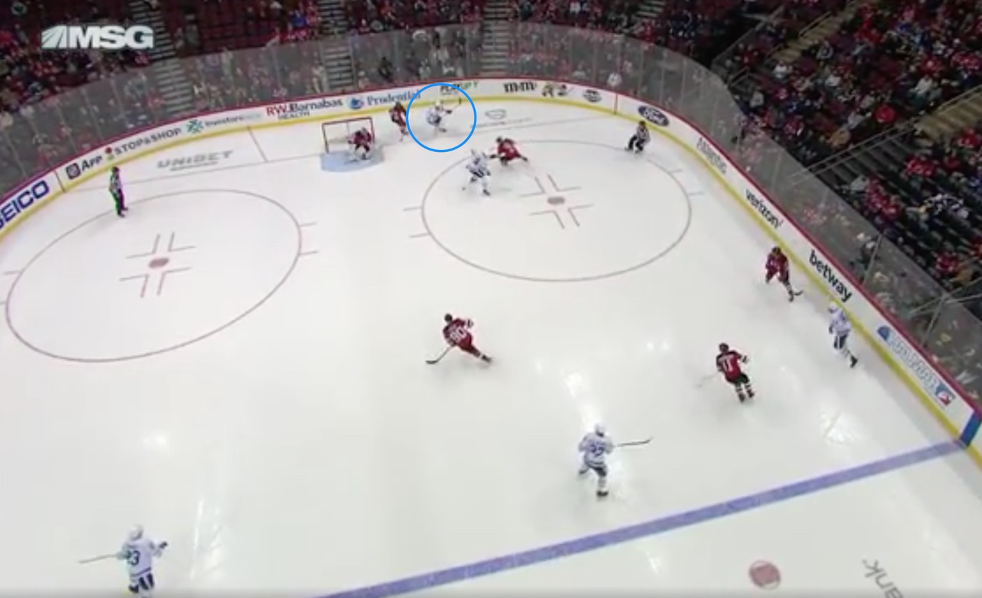
Simmonds gets high by the wall, and ends up with a puck exactly where we’re talking about…

And Engvall is coming up high and curling rather than going to the net…

…Which is where he ends up getting the puck, and a good look.

So that’s how the Leafs will operate without much resistance.
Now, there’s a greater question here: is that a good thing? Do you want Engvall coming up above there? Do you want shots coming from the higher slot in the playoffs, or are those goals more likely to dry up against good goaltending, which most playoff teams have? The Leafs obviously have a beautiful looking shot chart in general — it’s not like they don’t also get looks from in tight — but it would be important to note that internally, those high looks should be options B, C, or Z if they can find a way to get in tight first.
I mentioned off the top that it feels like there’s still more for the Leafs, and these things are related. With all their skill, and their use of the high slot, you’d think anything they’d get from in tight would be a lock to put away, but compared to some of the “heavier” teams, Toronto’s finishing in tight hasn’t been as good. I wonder if that’s related to most of their players being more likely to “drive by” that area than to inhabit it, or if it’s just luck.
Check out the finishing in tight from Minnesota, a team that’s quite a bit behind the Leafs in expected goals, but ahead in real ones:
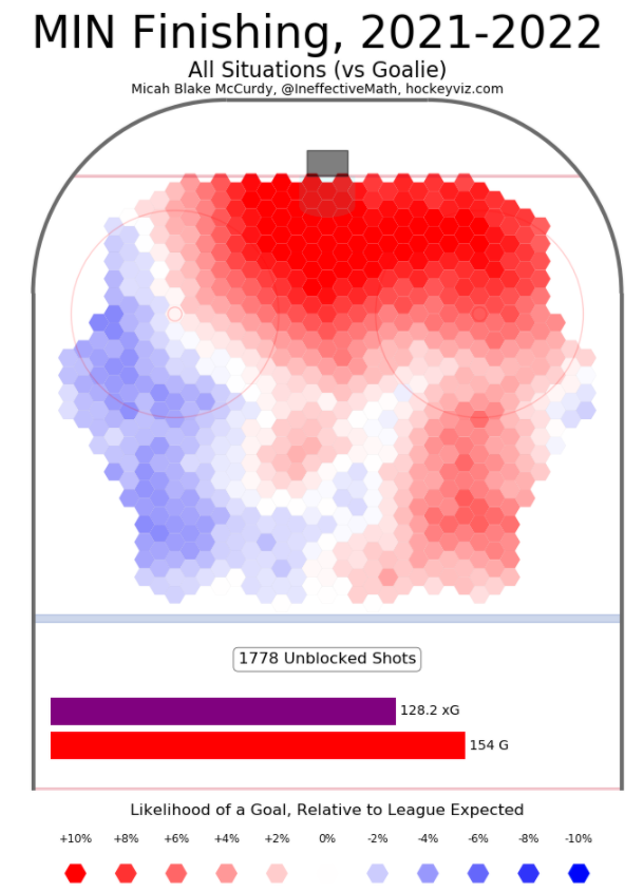
They’re deadly on top of the crease. That, to me, is a good playoff omen, no?
Now here’s the Leafs:

They finish at an above average rate from that high slot, but they’re below league average in tight. Colorado, Florida, and Carolina are all above average in tight.
One of the things that caught my eye is tips/deflections, which would involve a lot of luck. Here’s the Wild on tips/deflections, on which they’ve scored 17 times…on 13 expected goals.

They Leafs have tipped in 17 pucks too…
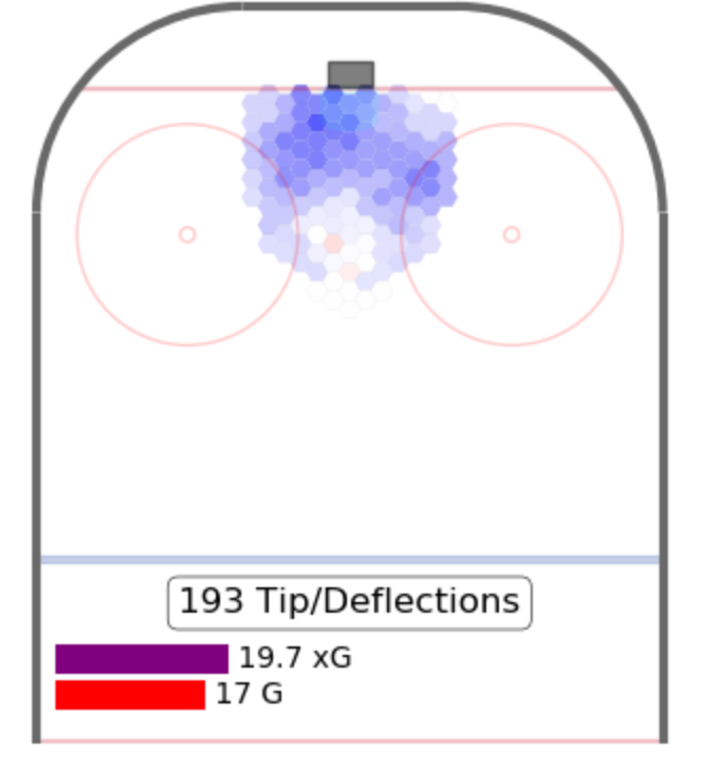
…on about 20 expected goals. They’re generated a lot there, it’s just not going in as often.
This is where I think there’s more for the Leafs. That, to me, seems like a team that hasn’t gotten particularly lucky offensively, despite their great output. They do have guys who can finish, even if their finishing hasn’t reflected that this season. Toronto’s team goal totals don’t just seem sustainable, but almost the minimum for the shots they’ve earned.
The Leafs create a ton, and from the most dangerous areas on the rink. They haven’t been overly lucky in creating the high goal totals, particularly in and around the net. Some may have questions about the usefulness of creating looks in the high slot for a team that’s seen its offence dry up in the post-season in the past, and it’s probably a fair concern. The Leafs likely would say it helps open up more ice for players shooting around the crease. But if that’s not being reflected in around-the-net finishing, is the strategy one that can have success in the post-season?
The Leafs were always going to be unable to silence the critics during this regular season, though they’ve done well to quiet them down. But until they find their way through a playoff series in April, it’ll be impossible to write these types of articles without those always present questions.
[relatedlinks]




